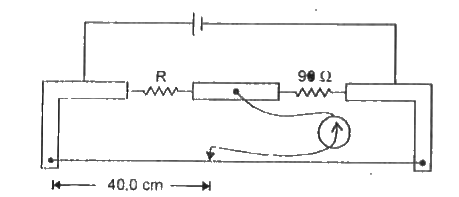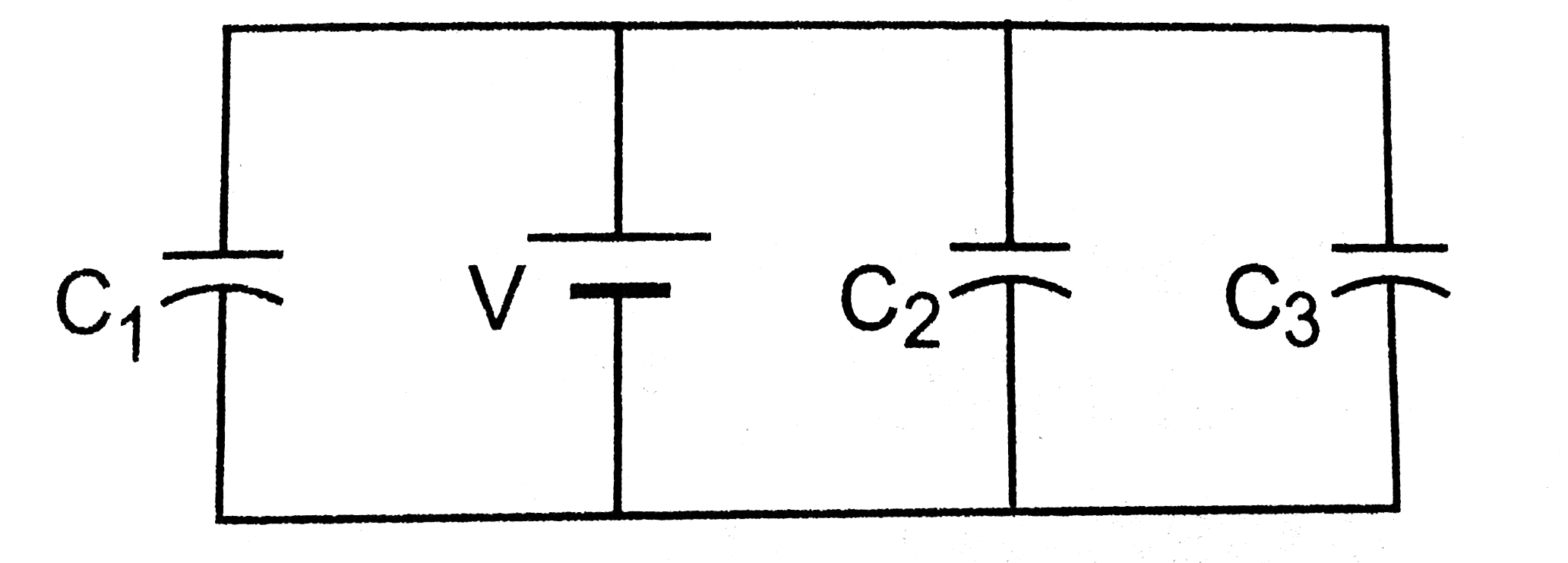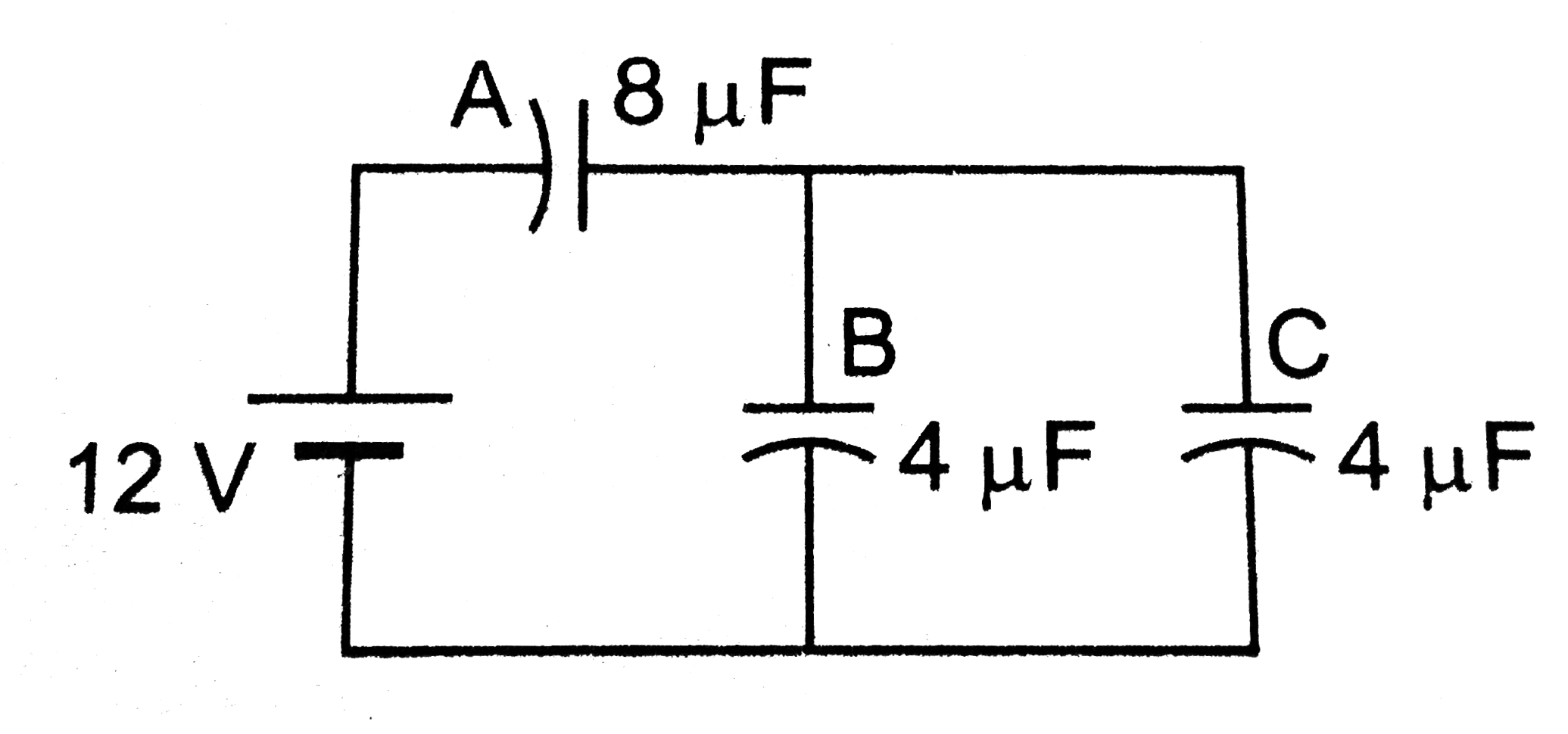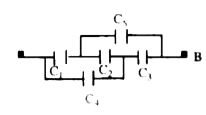तीन संधारित्र C1,C2 व C3 चित्रानुसार जुड़े हुए हैं। यदि C1= 2 μF, C2 = 3 μF तथा C3=5μF हो तो P व Q के बीच तुल्य धारिता क्या होगी ?

तथ्य : इस प्रकार की समस्या को तार समस्या (wire problem) कहते हैं। इसके लिए जितने तार होते हैं उन्हें अलग-अलग नंबर देते हैं। उप्युक्त समस्या में दो तार हैं जिन्हें निम्न प्रकार संयोजित (arrange) करते हैं-

अत: चित्र के अनुसार तीनों संधारित्र समान्तर क्रम में हैं।
∴ प्रभावी धारिता C=C1+C2+C3
=2μF+3μF+5μF
[चूँकि C1=2μF,C2=3μF व C3=5μF ]
=10μF
Topper's Solved these Questions
- BOOK - MITTAL PUBLICATIONCHAPTER - विद्युत धारिता EXERCISE - पाठ्य निहित उदाहरण19videos
विद्युत धारिता
- BOOK - MITTAL PUBLICATIONCHAPTER - विद्युत धारिता EXERCISE - पाठ्य पुस्तक (बहुचयनात्मक प्रश्न)13videos
विद्युत धारिता
- BOOK - MITTAL PUBLICATIONCHAPTER - विद्युत धारा के चुम्बकीय प्रभाव EXERCISE - प्रतियोगी परीक्षा संबंधी प्रश्न26videos
विद्युत धारा के चुम्बकीय प्रभाव
- BOOK - MITTAL PUBLICATIONCHAPTER - विद्युत परिपथ EXERCISE - प्रतियोगी परीक्षा संबंधी प्रश्न ( बहुविकल्पीय प्रश्न)20videos
विद्युत परिपथ
Similar Questions
पृथ्वी को एक गोलाकार चालक मानते हुये इसकी धारिता की गणना कीजिए। (पृथ्वी की त्रिज्या (R) = 6.4×106m )
05:33View Solutionकिसी गोलीय चालक की धारिता का मान समानुपाती होता है-
02:19View Solutionदो एकसमान तार A व B प्रत्येक की लम्बाई l में समान धारा i प्रवाहित है। A को मोड़कर R त्रिज्या का के वृत्त और B को मोड़कर भुजा a का एक वर्ग बनाया जाता है। यदि BA तथा BB क्रमशः वृत्त केंद्र तथा वर्ग के केंद्र पर चुंबकीय क्षेत्र है, तब अनुपात BA/BB होगा :
02:33View Solutionएक मीटर ब्रिज से 90Ω के मानक प्रतिरोध के साथ एक प्रयोग करते समय, जब जॉकी को तार के बायें सिरे से 40.0 cm पर दबाया जाता है, तब मीटर ब्रिज में प्रयुक्त पैमाने का अल्पतमांक 1 mm है। अज्ञात प्रतिरोध का मान है -
 03:28View Solution
03:28View SolutionIIf y=1+c_1/(x-c_1)+(c_2x)/((x-c_1)(x-c_2))+(c_3 x^2)/((x-c_1)(x-c_2)(x-c_3)) show that dy/dx=(y/x)[c_1/(c_1-x)+c_2/(c_2-x)+c_3/(c_3-x)]
05:55View SolutionFind the charges on the three capacitors connected to a bettery as shown in figure (31.E1). Take C1=2.0=2.0,μF,C2=4.0,μf,C3=6.0,μFandV=12vo<s.(31-E1). Take C1=2.0μF,C2=4.0μF,C2=6.0μFandV=12vo<s.
 04:50View Solution
04:50View SolutionFind the charges on the three capacitors connected to a bettery as shown in figure (31.E1). Take C1=2.0=2.0,μF,C2=4.0,μf,C3=6.0,μFandV=12vo<s.(31-E1). Take C1=2.0μF,C2=4.0μF,C2=6.0μFandV=12vo<s.
 02:10View Solution
02:10View SolutionC1+2.C2+3.C3+…...+n.Cn=
View SolutionC0C1+C1C2+C2C3+…+Cn−1Cn=
02:44View SolutionIf C1,C2,C3,C4 are the coefficients of any consecutive terms in the expansion of (1+x)n , prove that :
C1C1+C2+C3C3+C4=2C2C2+C303:27View SolutionIn Fig, 25-26 , find the equivalent capacitance of the combination. C1 is 10.0μF,C2 is 8.00μF, and C3 is 4.00μF
 View Solution
View SolutionCalculate the potential difference and the energy stored in the capacitor C_2 in the circuit shown in the Fig. Given potential at A is 90 V , C_1 = 20 mu F , C_2 = 30 mu F and C_3 = 15 mu F
09:37View SolutionConsider three circles C1,C2andC3 such that C2 is the director circle of C1,andC3 is the director circle of C2. Tangents to C1, from any point on C3 intersect C2, at PandQ. Find the angle between the tangents to C2 at P and Q. Also identify the locus of the point of intersec- tion of tangents at PandQ.
05:42View SolutionFind the charges on the three capacitors connected to a bettery as shown in figure (31.E1). Take C1=2.0=2.0,μF,C2=4.0,μf,C3=6.0,μFandV=12vo<s.(31-E1). Take C1=2.0μF,C2=4.0μF,C2=6.0μFandV=12vo<s.
 05:06View Solution
05:06View SolutionThe equivalent capacity between A and B in the given circuit is (C1=4μF,C2=12μF,C3=8μF,C4=4μFC5=8μF)
 05:30View Solution
05:30View Solution

